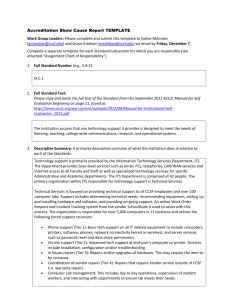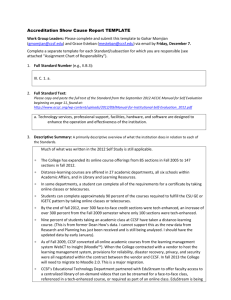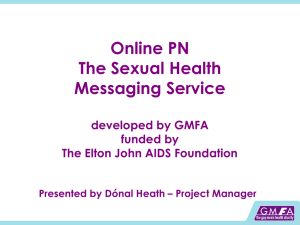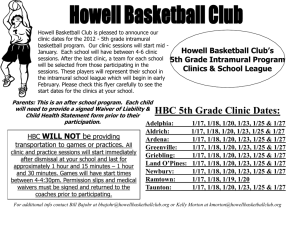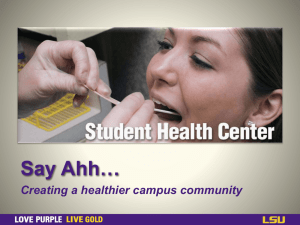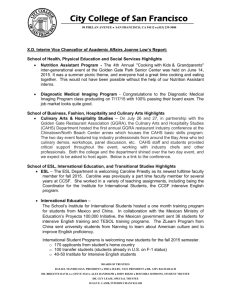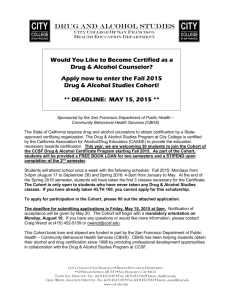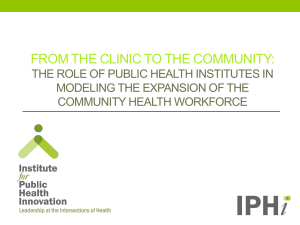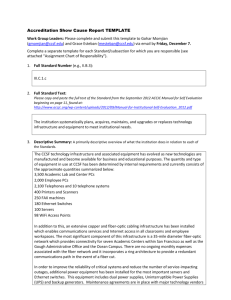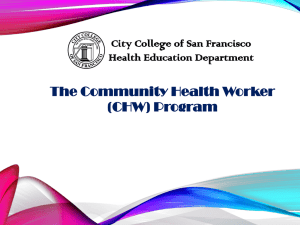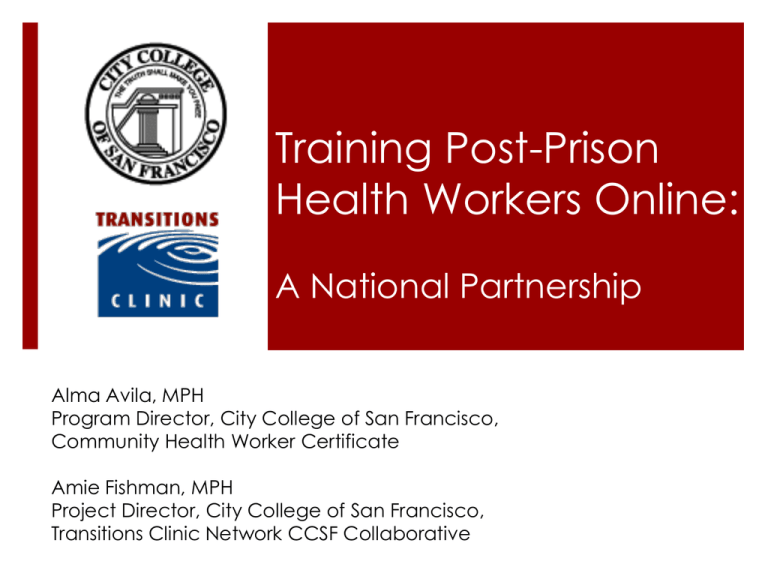
Training Post-Prison
Health Workers Online:
A National Partnership
Alma Avila, MPH
Program Director, City College of San Francisco,
Community Health Worker Certificate
Amie Fishman, MPH
Project Director, City College of San Francisco,
Transitions Clinic Network CCSF Collaborative
The project described was supported by Grant
Number 1CMS331071-01-00 and 1C1CMS331300-01-00
from the Department of Health and Human Services,
Centers for Medicare & Medicaid Services.
Disclaimer: The contents of this publication are solely
the responsibility of the authors and have not been
approved by the Department of Health and Human
Services, Centers for Medicare & Medicaid Services.
Health Care Innovation Award
(HCIA)
3 year award: Collaboration among CCSF, UCSF, Yale
and community clinic consortium
Train and employ formerly incarcerated individuals to
be Community Health Workers (CHWs) working in
primary care clinics
11 clinics in 7 states and Puerto Rico
Serving recently released prisoners with chronic
conditions
Evaluation to measure:
Increased access to primary care
Improved quality of care
Lower health care cost
Why focus on re-entry?
700,000 federal and state prisoners are released to the
community annually
High prevalence of chronic conditions; diagnosed for
the first time while incarcerated
Isolated from the community, health and social
services
Limited access to medical care and medication post
prison
12 times increased risk of death in first 2 weeks after
release
More likely to use emergency department for primary
health care
Transitions Clinic Network
Community-based intervention that provides
transitional care and a primary care medical home
for recently released patients with chronic conditions
and their families
Employs formerly incarcerated CHWs as part of a
clinical team to outreach, enroll and support them in
primary care and other social services
Partners with county health departments, academic
institutions, community clinics and prisons to provide
primary care to the re-entry community
Eleven clinics across the country currently in operation
with approximately 5 more in development
Why Community Health Workers
Members of the same communities as clients, which
helps to build trust and understanding
Meet the clients “where they are at” and build a
bridge to primary care
Assist with patient navigation in a culturally relevant
manner
Help to advocate for clients
Evidence-based model:
Reduced emergency room visits = decreased health care
costs
Increased access to primary care
Coordinated care = improved quality of care
Post Prison Health Worker
Certificate (PPHW)
Trains and prepares frontline community health
workers to work with and promote positive health
outcomes for formerly incarcerated communities
20 units – 2-3 semesters for completion
Core Competencies
Case management
Culturally responsive outreach
Client centered intake and counseling skills
Community organizing and advocacy
Internship component
Developed in partnership with Transitions Clinic
Program Features
Performance-based Training Program
Reality-based Education
Internship
Partnership with Employers
Course Demonstration
Course Demonstration
Use of videos in courses
As introductions to key learning points
There are over 150 videos to embed in online and inperson courses on core competencies, roles of CHWs,
working with clients, and more
The following 2 videos demonstrate the following learning
outcomes. See if you can identify one example for each
key points as you watch the videos
Key learning points
How to:
Begin the client interview
Build rapport
Welcoming the client
Making the client feel comfortable
Apply active listening skills
Course Demonstration
Role Play:
First Meeting, CHW & Client – 01 Demo
First Meeting, CHW & Client – 01 Counter
Examples?
Questions are then asked in forum or discussion boards:
1. What were some of the differences between the first and
second interview in making the client feel more
comfortable in the interview?
2. What were some of the skills used?
3. Name 2 positive and 2 negative “non-verbal”
communications methods used.
Challenges
Technology barriers:
Student learner literacy
Faculty literacy
Access (computers, webcams, videos, external
sites)
High level of support needed for success
Practice-based learning online
Group work:
Conflict resolution
Giving / receiving critical feedback
Community building
Employer and peer discrimination
Challenges continued
“I guess not sitting in a class is still different for me. I
know the engagement of a classroom is somewhat
missing.”
“I have a large amount of people who support me at
the job. The only problem is time factor to do all that
the job requires and getting the time to complete
school work. Since I work at two locations it makes it
harder.”
“It just felt as though I could not keep up this semester.
I will have to assess and re-organize for the future.”
“I need a little support with understanding the
newness of technology as a whole; I just came home
from 27 years of incarceration. There is no internet in
New York State prisons.”
Highlights and Opportunities
Increased workforce opportunities in the expanding
health field for historically marginalized communities
Expansion of online certificate program provides
greater access to remote areas and areas without
training opportunities
Opportunities to collaborate or partner with other regional
training institutions or clinics
Creation of culturally relevant videos and training
resources
Development of online facilitator’s guide to
accompany Foundations for Community Health
Workers textbook
Resources: CHW Textbook and
facilitator’s guide
Resources: PPHW certificate
Resources: Digital Stories
Jermila’s story
Tracy’s story
Contact Info
Alma Avila
aavila@ccsf.edu
Amie Fishman
afishman@ccsf.edu
City College of San Francisco
MUB 353
50 Phelan Ave
San Francisco, CA 94112
The contents of this publication are solely the
responsibility of the authors and have not been
approved by the Department of Health and Human
Services, Centers for Medicare & Medicaid Services.


